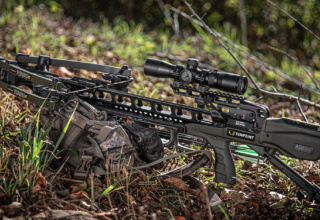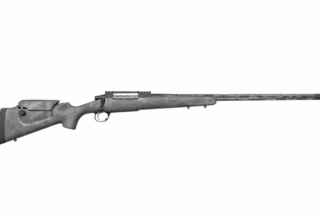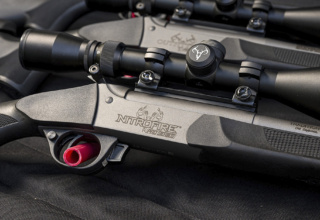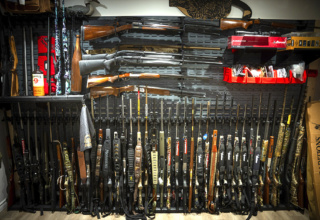Rolling dunes, prairie grass, big bucks, a gun, and a crossbow… Does it get any better?
by Brad Fenson
It was the first day of our Nebraska archery hunt, and the winds were steady and strong, whistling through the trees with concerning force. We set up Delta McKenzie targets at 30, 40, and 50 yards and shot arrows to see what happened to the point of impact. Tucked in behind a dense shelterbelt of cedars and cottonwoods, the heavy arrows I had chosen moved so little that you would not say it was an issue. Scott Fink, of Goose Creek Outfitters, had a box blind picked out for me that was also on the downwind side of a dense shelterbelt, meaning I would not have to worry.
I sprayed down head to toe with Scent Killer Gold and crawled into the blind mid-afternoon and immediately saw deer funnel in and out of cover.
Nebraska whitetails live with wind most of their lives and go about their business like nothing is wrong. I had my TenPoint Carbon Nitro RDX crossbow, which was perfect for hunting from the tight confines of a blind. We were situated downwind of the trees and a newly emerged crop focused the deer’s attention.
Does and fawns trickled in and out of cover, paying little attention to the wind. Their ears worked like radar dishes, but their bellies dictated priorities. Small bucks chased in and out of the trees playfully, making me think the rut had not fired up.
White antlers moving through a creek bottom about 250 yards away caught my attention, and I locked my binocular on a pair of bucks headed for the woodlot I was watching. Both were mature deer with big bodies, but the one with tall antlers immediately stood out. The duo trotted up the creek, cut across a depression in the open grassland, and snuck into the cedars. Mayhem erupted as the bucks chased all the deer in the trees. Does and fawns were running full speed down the entire length of cover, and for a moment I worried they might all blow out the far end and keep going.
Like a good border collie moving cattle, the bucks cut the does off and sent them running back to the other end of the cedars. It was like watching a documentary on deer behavior. The bucks chased, made scrapes, rubbed trees, used licking branches, and made sure all creatures knew the trees were their territory.
My target buck ran back and forth in front of me at least four times, never offering a good shot opportunity. I ranged him at 76 yards, which is too far for a bow shot in my books. The deer had been running for close to two hours, and as the sun was setting, the buck finally fed out of the trees by himself and slowly moved towards me. I felt like I was in a chess game, watching the deer take three steps closer only to take two back towards cover. The buck fed right past my blind and ended up at 46 yards quartering away from me. The wind was gusting, tree limbs were swishing and swaying, and when I pulled the trigger, the deer did not react a single bit until the arrow had passed through him. He had not heard a thing.
The buck took off at full speed, jumped the fence, and headed around the corner of the trees. Just before he was to run out of sight, I saw him tip over in the tall grass. With my Nebraska archery buck in the bag on the first day of my hunt, I had to pinch myself to make sure it was real. I rarely find my target buck on the first day of any hunt, but I was not complaining.
It got dark fast and started to snow as I followed the unmistakable trail left by the buck. He was even better than anticipated, with five even points on each antler. I was not concerned about being tagged out early, as the Sandhills are a hunter’s playground. I had licenses for prairie chicken, pheasant, and fall turkey. I would have a couple of days to explore some new country before the opening day of the deer rifle season, for which I also had a license.
The Nebraska Sandhills cover over 20,000 square miles, with some dunes reaching 300 feet in height. The tall bunches of grass are what hold the dunes in place, providing high protein feed and cover for an abundance of wildlife. Wetlands are well hidden in the dips and depressions between dunes, which act as an oasis for a plethora of wildlife that you can stumble into when you least expect it.
Opening day for the rifle season came fast. Chasing birds and processing deer made the days fly by quickly, and I was back in the hills looking for a second big buck. Scott had convinced me to check out a pasture that undulated as far as the eye could see. There had been a couple of big mule bucks hanging out in the area, and we were hopeful we would spot one. The area of Nebraska I was hunting allowed me to harvest a white-tailed or mule deer on my license. Having the option was a great advantage.
We watched the sun come up and glassed for close to an hour, finding new deer every couple of minutes. The dips and valleys hid over half of the land mass in front of us, and being patient revealed where the deer wanted to hang out and when they moved. If you were not glassing continually, it would be easy to miss a big buck traveling over a ridge and into the next draw.
Scott described the mule buck several times, giving me a mental image of its big frame, with a few non-typical points. I was anxious to get a glimpse of the old boy.
Something in the side mirror of the truck grabbed my attention, and a better look with my binocular revealed a herd of mule deer moving between dunes at 150 yards. We counted nine does followed by a fork-horned buck, leaving us sure the big boy was not far behind. With the rut in full swing, it would be unusual for a forked buck to have such a large harem. Unfortunately, no matter how hard we glassed, a mature buck never materialized.
We watched the sunset and eventually headed back towards camp. While approaching a shelterbelt, we found another large herd of mule does. Several bucks ran from cover to chase a hot doe, and we watched the action in the fading light. Two medium-sized bucks chased, postured, and squared off with each other without ever getting into a serious fight. The big buck we had spent all day looking for was not in the group, but we knew the area would be the perfect place to start the next day.
The following morning, we headed out an hour before shooting light. Scott had seen the big mule buck several times over the fall, and it was usually early in the morning. We approached the area we had found the herd of mule deer the evening before and stopped to glass the tall, dry sunflowers the deer used to hide. Scott and I were used to hunting together, and both lifted binoculars to start scanning. It only took seconds to locate the herd, which had only moved about 200 yards. Before the words could cross my lips, Scott said, “Your buck is standing on the far left of the does.”
The hulking body and a tall silhouette of antlers filled my field of view. The buck looked much darker and bigger than any of the other deer. It was still well before legal light, and we sat quietly to watch the deer as the sun slowly started to brighten the horizon. The mature antlers were hard not to look at as I tried to count points and identify stickers.
It was time to make our move, so Scott and I tried to read the lay of the land to come up with a plan to get within shooting distance. The deer paid no attention to us, giving us lots of time to let the sun brighten the landscape. With a dozen sets of eyes and ears, though, I knew I had to be quiet and cautious. There was not a breath of wind—meaning I would need to be stealthy to close the distance.
There was a slight hill south of the deer, and if I snuck down the edge of the shelterbelt, I would be able to get to the barbed-wire fence near the top of the rise. Using the terrain like the deer do to remain undetected was the best strategy, and I slipped down the edge of the trees to start my stalk.
Carefully watching my foot placement, it did not take long to cut the distance. As I got close to the fence, I crawled to one of the posts where the deer came into view.
The deer were spread out in front of me, and my elevated position gave me a better view of the herd. I shouldered my Traditions G2 rifle and cocked the hammer. The old buck turned and stared right at me, just as I found him in my scope. I had a solid rest against the post and slowly tightened up on the trigger until the rifle barked, echoing back off the surrounding hills. The buck took two steps and hit the ground before I could get another cartridge in the gun. The .35 Whelen bullet hit the buck hard, anchoring the old boy and eliminating the need for any tracking.
The does and small bucks were not sure where the noise came from and stood to stare in different directions. A big doe finally headed for the hills, with the entire herd following. Scott raced over to join me as I headed down through the sunflowers to get a better look at my buck. The deep forks and extra points were exactly as Scott had described them. The body of the old deer was massive, and he smelled like rut. The buck had done a good job of hiding for several days but slipped up when he visited the local ladies.
Two tremendous deer in less than a week was like a dream come true. Being able to harvest a whitetail and mule deer was a bonus. On the way back to camp, we spotted some big white-tailed bucks, leaving little doubt I will be back next year.
Traditions Performance Firearms Outfitter G2
Traditions Firearms is best known for muzzleloaders but expanded into centerfire rifles with the Outfitter G2, a break-action single-shot cartridge rifle. The Outfitter G2 was replaced in 2020 with the Outfitter G3.
The difference between the G2 and the G3 is the trigger system. The Outfitter G3 is equipped with Traditions new Elite XT trigger system. The Elite XT trigger system is designed with a rebounding hammer, a captive half-cock, and a manual cross-block trigger safety. The Elite XT trigger allows the action to be broken open with the cross-bolt safety engaged which allows you to load or unload your Outfitter G3 and view the chamber. It also provides a crisp, accurate trigger.
There are numerous calibers offered that include 350 Legend, .35 Whelen, 450 Bushmaster, 45/70, 300 AAC Blackout, .35 Rem, 357 MAG, and .44 MAG. Muzzle brakes come on the .45/70, 450 Bushmaster, .35 Whelen, and 350 Legend. These calibers as well as the .35 Rem, .357 MAG, and .44 MAG have a 22-inch Premium Lothar Walther chromoly steel barrel. The .300 AAC Blackout has a 16.5-inch Premium Lothar Walther chromoly steel barrel and a threaded end.
The .45/70, 450 Bushmaster, .35 Whelen, 350 Legend, and .300 AAC Blackout come with the Quick Detach forend, which allows you to remove the forend with the push of a button for easy breakdown.
All the calibers are available scoped or non-scoped and have a Premium CeraKote Finish on the outside of the barrel. The .45/70, 450 Bushmaster, 350 Legend, and .35 Whelen come scoped with BDC scopes for the caliber.
























